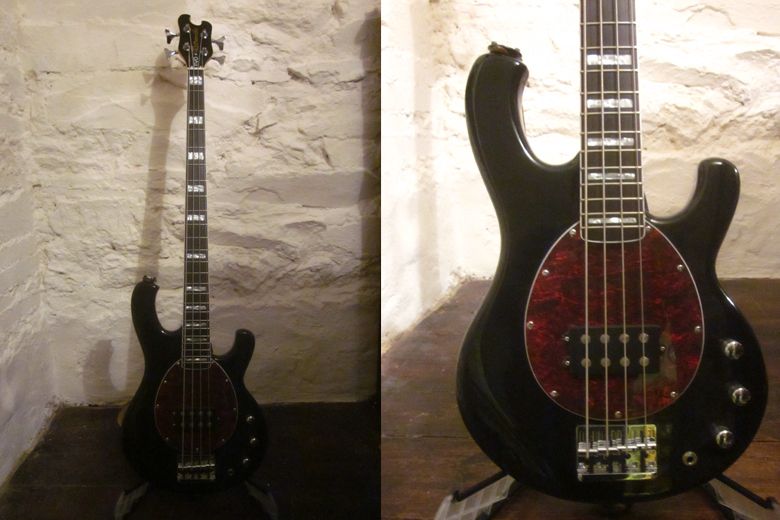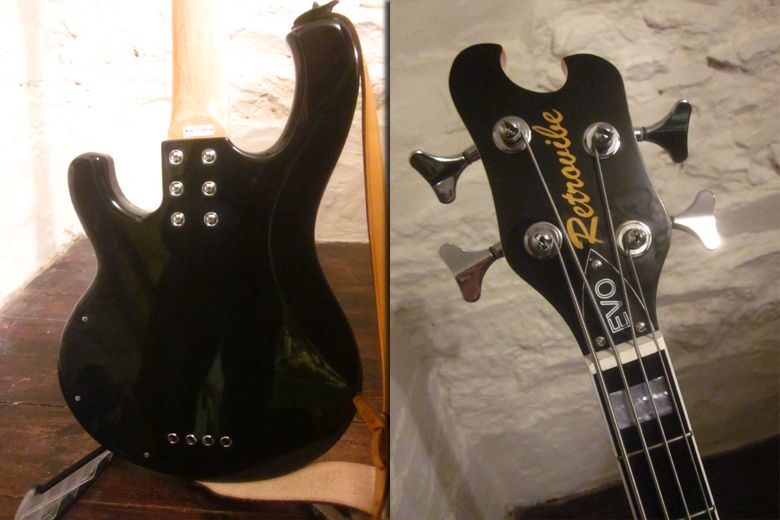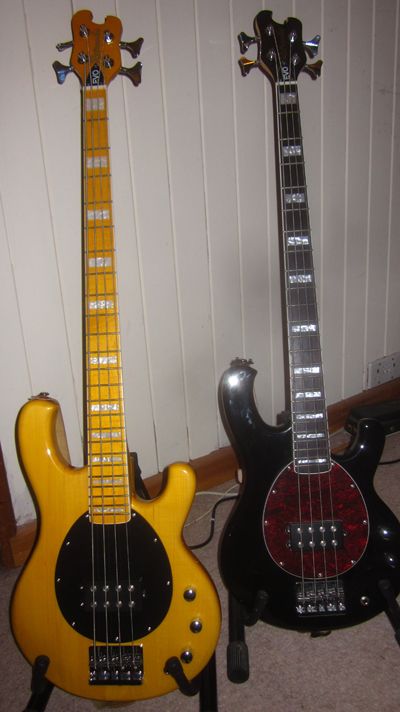ProBass Retrovibe basses are the brainchild of David Konig who gets the basses built in China to his exacting specifications and then sells them to UK and European customers via his website. With no middlemen involved and no distributors or stockists other than Konig himself, he is able to keep these basses extremely competitively priced. In fact, the whole current range consists of basses costing between £249 and £319 plus post and packaging fees.
Retrovibe's debut model was the RV4 (and RV5 five-string model) strongly influenced by Rickenbacker's 4000 series bass guitars and equipped with two MusicMan style humbuckers. At the request of RIC, that particular model has now been discontinued. Its replacement was the Retrovibe Vantage which I can best describe as looking as if it's the offspring of an intimate liasion between a Rickenbacker 4003 and a Fender Jazz Bass. More recently Retrovibe have followed this up with the Zygote which appears to be a more evolved version of the Vantage, and the EVO, which is the bass we are looking at here.
But before I go on, let me backtrack and set the scene a little. I was recently offered some bass playing gigs with a local psychedelically-inclined band called Sendelica, to stand-in for their usual bassist on certain gigs that he's not able to play. Some of you may well have heard of them, being very well known on the psyche, "space rock" and progressive scene and having had recorded with specialist vinyl-only record label Fruits De Mer (which itself has something of a cult following). I didn't hesitate too long before accepting this offer, even though I didn't really have a bass suitable for the gig. I started practising using my Fender Pawn Shop Bass VI but pretty soon decided that for Sendelica's songs I wanted to use a Drop D tuning, and on a short-scale instrument like the Bass VI where the low E string can often be a bit flabby, tuning down to D wasn't going to be an option.
I decided I needed a regular long-scale, 4-string bass, and so spent days scouring the internet for suitable candidates that I thought would be within my budget. I didn't want to go the P-Bass or J-Bass route, not being a particular fan of either of those. I toyed with the idea of a Thunderbird style design, maybe an Epiphone or an ESP, but then I found many reviews criticising such basses as being extremely neck heavy.
 |
| Sendelica live at the Zephyr Lounge, Leamington Spa, 7 March 2014. Me on the right on the Retrovibe EVO bass. Photo: Matty Dread |
So, enough of my life story for the time being... What's the EVO like? The website tells us that it "draws on many different styles, old and new, to deliver a robust and eye-catching design which sounds as good as it looks", and in the case of the EVO those different styles include Musicman Stingray, Rickenbacker, Fender Jazz Bass, and Warwick. To clarify, it does look a bit like a Musicman Stingray (especially with that ovoid pickguard) but has a more compact body, the horns of which have a touch of Rickenbacker about them; the 24-fret neck is beautifully bound, has pearloid block markers, and tapers to a narrow Jazz Bass-like 38mm at the nut; the headstock reminds me of those of Warwick basses, but with a little cut-out which makes it almost Rickenbacker-like. It does look to be a really classy instrument.
The body is basswood (as you'd probably expect), the neck is maple and beautifully finished (none of this "satin feel" crap, i.e. unfinished necks you find on so many cheaper guitars) and it has a rosewood fingerboard (plus white binding and block markers as already mentioned). It's a bolt-on neck, attached to the body by no less that six bolts - that neck ain't going to move!
The hardware - bridge, tuners, control knobs - are all very substantial and on this example are finished in chrome. Pickup-wise we have one MM-style humbucker although you may have noticed in the photos there are three controls. This set-up is more versatile than you may think, with two volume controls - one for each coil of the MM-style pickup - and a single tone control. It essentially functions as a two pickup instrument and despite the proximity of the two coils there are a wide range of tones to be dialled in.
I was practising with this bass every day for a month solid (I had a lot of material to learn!), and have since gigged with it and recorded with it. I found that the EVO hangs well upon a strap so that the neck is positioned just where I want it. The neck is a joy to play. As someone more familiar with guitar string spacing, the narrow spacing up at the nut suits me fine, and the large block markers are invaluable for helping me navigate around the fingerboard. The EVO certainly delivers sound-wise; I found it sat very nicely in the live mix along with lead guitar, saxophone, drums, and various samples all doing their thing. The tuning is stable and the bass happily handles my Drop D tuning with no sign of flabbiness on the lower string.
The build quality and finish are excellent. I actually showed my EVO to a luthier whilst I was picking up another guitar he'd been working on. He seemed quite impressed with the quality; he did comment that the action could be even lower but I personally wouldn't want it any lower, it suits me fine as it currently is. If I did have to nitpick, I'd mention that there are a few sharp-ish fret ends that could benefit from a fret dress, however thankfully these are on the bass side rather than the treble side of the fingerboard and so my fingers rarely encounter them. That, and the "EVO" text on the trussrod cover is slightly askew... but THAT really is splitting hairs!
Those minor points aside if there was one slight niggle that I personally have about the EVO it would be that, as someone who is - shall we say - well-built, I sometimes wonder if the compact body shape might make the bass too small for me. But then I remind myself that it DOES hang very nicely on a strap, presenting itself in the perfect playing position. (And remember of course there are much smaller-bodied instruments played by bassists of all shapes and sizes, for instance minimalist Steinbergers and that whole kind of thing.) Another positive is that the EVO would suit players of a smaller stature, younger players, female players, etc. Weight, by the way, is approximately 3.5kg / 7.4lbs.
As you may have gathered I am quite a fan of this bass. I really think I made the right choice. In fact, I am seriously considering buying a second example to keep in regular tuning and as a back-up bass at gigs. (Actually I'd love a fretless EVO if that was ever to become an option).
Retrovibe basses are produced in a number of different finishes, with each being strictly a limited edition. Of the five finishes available on the EVO, there were only eight examples of each produced. Maybe, if the range is successful, there might be further production.
Priced at £249 / £279 / £289 depending on finish options.
Available online only from probass.co.uk
ADDITIONAL (3 April 2014): Just to show that I put my money where my mouth is, I did indeed buy a second Retrovibe EVO (see photo opposite). That's a Transparent Amber finish. Very nice indeed!
G L Wilson
© 2014, Guitarz - The Original Guitar Blog - the blog that goes all the way to 11!
Please read our photo and content policy.




Very nice find. All models look really classy and you say that they sound good. I hope this blog will help EVO to sell many instruments just because they deserve it... Even if ,like most guitars today,these are manufactured in the far east, at least they have been designed in Europe and create a european business around. Thumbs up!
ReplyDeleteI've the Evo and the Zygote models. Lovely basses that do deserve to be better known.
ReplyDeleteDave from Probass is a Top Man to deal with too.
He knew I was after a Vintage V1004 and last month sent me a link to one up for sale like I said Top Man.